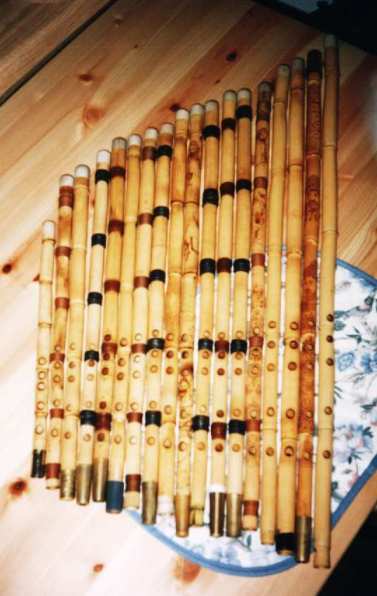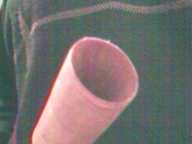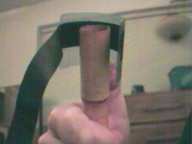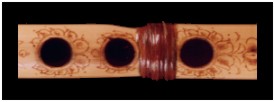

|
The best way to buy a Persian ney is through someone you know who plays well. There is no way to tell if a ney is good or bad by visual inspection, only an expert player can tell by playing it. Some Persian stores sell neys, but they are usually of very poor quality. An internet seach may find you a ney for sale. Today I found 3 sites which have neys for sale, priced $40, $110, and $250. I currently charge US$110 for a ney.
People often ask me what length of ney they should buy. For a large ney the low notes are more difficult but the high notes easier. For a small ney the high notes are difficult but the low notes easier. For neys in the range Bb-C (F-kuk to G-kuk), the difficulty is more or less balanced, so this is the length I recommend for starting off. These are also very common sizes for ensemble playing though there is great flexibility in pitch in Persian music, and all pieces can and are transposed to any key. Neys larger than Bb are very difficult in the bam. Neys shorter than C are very difficult to play in the gheesh. They are also not easy to find except the A ney which is somewhat common.
There is really no pitch standard in Iran, and all traditional combinations of instruments that include ney are such that the other instruments can tune to the ney. However, there are uses for all lengths of ney from short to long, so when you reach the point that you are playing with other people you need a full set of neys of all lengths. For myself a B (lowest note) ney has the best balance between high and low note difficulty, though large and small neys are enjoyable to play too, because they all have a different character.
I bought my first ney in a Persian store in Los Angeles. I didn't know it was a ney when I saw it, and the store owner was not sure either. Fortunately he knew someone who could play a bit, and he confirmed it was actually a ney, and I bought it. This was my first ney. It turned out to be a good one, so I must have been lucky.
Since then I've been collecting neys from various sources; travelers to Iran, and visiting musicians. The best neys I have bought from a ney master from Isfahan who has visited me several times in Vancouver, Mr. Ghayori. He has studied and lived with Hassan Kassai, the most esteemed player of all, and makes neys himself.
If the ney gets very wet from playing, it is a good idea to dry it off after you are finished, especially in moist climates. If you don't do this mold will form inside the ney and it will turn black. This has no effect on the sound but it is not healthy and smells bad. After a ney blackens there is no way to get rid of it. To wipe the ney I use a "snake", used to clean trumpets. I remove the brush and attach a small piece of cloth instead which I swipe through the ney. Never use a blowdryer or any other direct heat. I tried this and ended up with a crooked warped ney.
When you store the ney make sure it can breathe, so don't put it in an airtight box. It is OK to stand the neys upright leaning against a wall, I have done this for years without warping.
The top of the ney can optionally be covered with a mouthpiece (sari) which should act as an extension of the ney. The best material is X-ray film, but plastic cut from a soda bottle, or the plastic inside men's shirts collars will work fine too. However some people use brass and claim it gives a better sound, but I disagree. Brass is bad for your teeth and does not give a better sound. Make sure the plastic is wrapped tightly.
 |
 |
 |
The nodes of the ney (where the braches of the plant were cut) are often wrapped with rotan or other ornamental material. This is for visual purposes only. I sometimes remove them, as I find the plain cane nicer looking.
When you are playing with instruments of fixed pitch the ney can sometimes go slightly out of tune due to a chance in humidity and/or temperature. In this case a mouthpiece can be used to lengthen or shorten the ney slightly. A bottom cover can be used also for tuning the bottom note.
If you play directly on the cane, which produces the best sound, you must wrap the top with transparent tape, or with duct tape, or any kind of tape, to prevent moisture penetrating the ney from the outside. I recently discovered this after playing some instruments without any protection: they have both cracked at the top!
If your instrument develops a crack, apply some crazy glue (CA glue) to the crack. Curiously the instruments that I have that have cracked actually play better after they cracked. Neys are amazingly robust! I once sacrificed a ney by sawing it in half, I wanted to see what it looked like inside. After that I glued the pieces back together, expecting the ney to be ruined, but it plays just fine. Some time ago I accidentally stepped on a ney and it splintered. I applied a coating of crazy glue and it plays just fine now.
 |